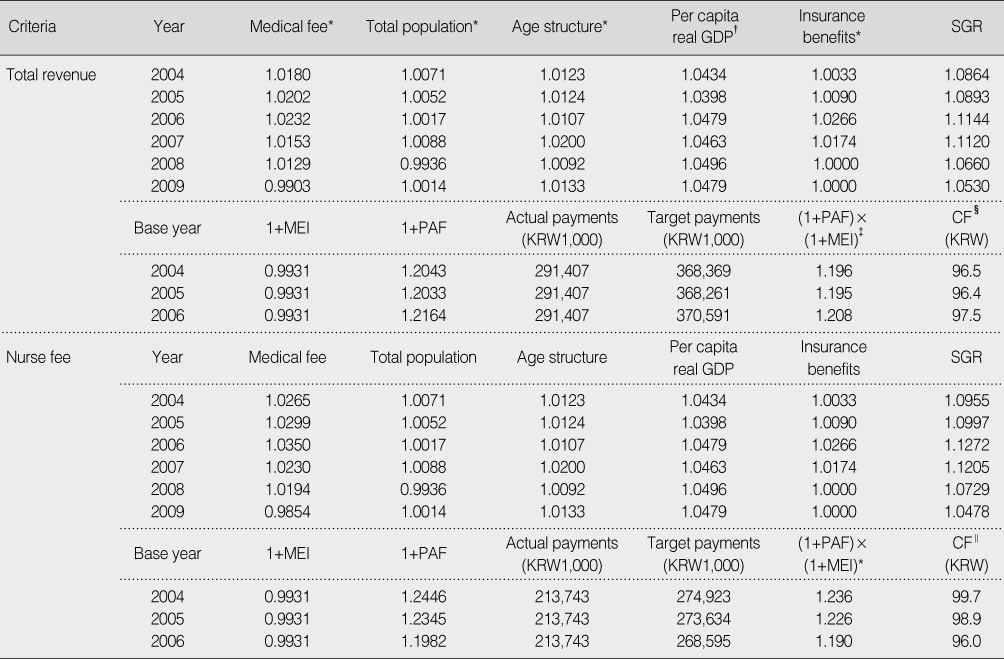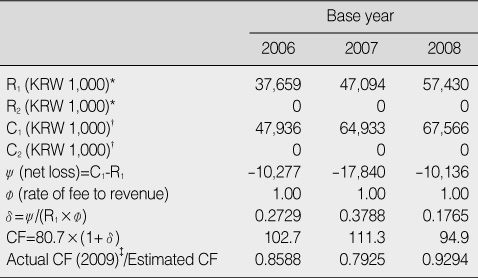Articles
- Page Path
- HOME > J Korean Acad Nurs > Volume 39(4); 2009 > Article
-
Original Article
- Methods and Applications to estimate the Conversion Factor of Resource-based Relative Value Scale for Nurse-Midwife's Delivery Service in the National Health Insurance
- Jinhyun Kim, Yoomi Jung
-
Journal of Korean Academy of Nursing 2009;39(4):574-583.
DOI: https://doi.org/10.4040/jkan.2009.39.4.574
Published online: August 31, 2009
1Associate Professor, College of Nursing, Seoul National University, Seoul, Korea.
2Doctoral Student, College of Nursing, Seoul National University, Seoul, Korea.
- Address reprint requests to: Jung, Yoomi. College of Nursing, Seoul National University, 28 Yeongeon-dong, Jongno-gu, Seoul 110-799, Korea. Tel: 82-2-740-8459, Fax: 82-2-766-1852, wow30@snu.ac.kr
Copyright © 2009 Korean Society of Nursing Science
Abstract
-
Purpose
- This paper analyzed alternative methods of calculating the conversion factor for nurse-midwife's delivery services in the national health insurance and estimated the optimal reimbursement level for the services.
-
Methods
- A cost accounting model and Sustainable Growth Rate (SGR) model were developed to estimate the conversion factor of Resource-Based Relative Value Scale (RBRVS) for nurse-midwife's services, depending on the scope of revenue considered in financial analysis. The data and sources from the government and the financial statements from nurse-midwife clinics were used in analysis.
-
Results
- The cost accounting model and SGR model showed a 17.6-37.9% increase and 19.0-23.6% increase, respectively, in nurse-midwife fee for delivery services in the national health insurance. The SGR model measured an overall trend of medical expenditures rather than an individual financial status of nurse-midwife clinics, and the cost analysis properly estimated the level of reimbursement for nurse-midwife's services.
-
Conclusion
- Normal vaginal delivery in nurse-midwife clinics is considered cost-effective in terms of insurance financing. Upon a declining share of health expenditures on midwife clinics, designing a reimbursement strategy for midwife's services could be an opportunity as well as a challenge when it comes to efficient resource allocation.
- 1. Ahn TS, Lee PS, Oh DI, Lee YT. Cost analysis of clinics and hospitals. 2001;Seoul, Seoul National University, Business Research Center.
- 2. Ahn TS, Park EC, Kwon HG, Ahn IH, Choi BH. Cost analysis of health care institutions from financial statements. 2002;Seoul, Seoul National University, Business Research Center.
- 3. Cho H. A study on the method to estimate the cost of hospice care. Journal of Korean Academy of Nursing. 1994;24:216–225.ArticlePDF
- 4. Cho SY, Park JH. Development of a nursing fee schedule model. Journal of Korean Academy of Nursing. 1993;23:68–89.ArticlePDF
- 5. Choi BH. Medical fee contract system: Review and prospects. Korean Journal of Insurance Medicine. 2003;3:68–78.
- 6. Choi BH, Hur SI, Kang GW, Eun SJ, Shin JE, Moon SH, et al. Payment policy reform in the national health insurance. 2007;Seoul, Korea Institute for Health and Social Affairs.
- 7. Choi BH, Shin YJ, Shin HW, Oh DO. Modelling an sustainable growth rate-based conversion factor for resource-based relative value scale. 2003;Seoul, Korea Institute for Health and Social Affairs.
- 8. Health Insurance Review & Assessment Service. Health insurance claims data. 2008;Seoul, Author.
- 9. Jeon CS. Review and prospects for medical fee contract system in Korea. Korean Journal of Insurance Medicine. 2008;3:53–60.
- 10. Jeong DC. How to optimize physician fee: Conversion factor for clinics in the national health insurance. Paper presented at the meeting of the Korean Health Economics Society. 2007;11;Seoul.
- 11. Kim JH. An empirical analysis of conversion factor for relative value scale in the National Health Insurance. Journal of Health Economics and Policy. 2005;11(2):33–64.
- 12. Kim JH. Methods and applications in calculating conversion factor. Paper presented at the meeting of the Korean Health Economics Society. 2007;11;Seoul.
- 13. Kim JH, Choi BH. Classification of conversion factors for resource-based relative value scale in the National HealthInsurance. Journal of Preventive Oriental Medicine. 2006;10(2):147–158.
- 14. Kim JH, Jeong HY, Kim JP, Song JH, Ryu GC, Yoo WG. Estimation of conversion factors for the year 2005 in the national health insurance. 2004;Gimhae, Inje University, Health Science Research Center.
- 15. Kim JH, Lee JK, Jeong HJ. An sustainable growth rate-based conversion factor for resource-based relative value scale in the national health insurance. 2004;Seoul, National Health Insurance Corporation.
- 16. Kim JH, Ryu GC, Yoo WG, Jeong EH, Jeong HJ, Lee TJ. Estimation of conversion factors for the year 2009 in the national health insurance. 2008;Seoul, Seoul National University.
- 17. Kim JH, Ryu GC, Yoo WG, Jeong EH, Yi JO. Estimation of conversion factors for the year 2007 in the national health insurance. 2006;Seoul, Seoul National University.
- 18. Kim JH, Yi HY, Jeong HJ. A national survey of out-of-pocket payment in the national health insurance. 2008;Seoul, National Health Insurance Corporation.
- 19. National Health Insurance Corporation. 2007 National health insurance statistical yearbook. 2008;Seoul, National Health Insurance Corporation.
- 20. National Macroeconomic Data. Korea National Statistical Office. 2008;Retrieved September 30, 2008. Available from: URL:http://www.kosis.kr.
- 21. Oh DI. Methods of calculating medical cost and recommendations: Conversion factor for hospitals in 2008. Paper presented at the meeting of the Korean Health Economics Society. 2007;11;Seoul.
- 22. Park JH, Song MS. Determination of nursing costs for hospitalized patients based on the patient classification system. Journal of Korean Academy of Nursing. 1990;20:16–37.ArticlePDF
- 23. Park SG. Problems and alternative policy for medical fee contract system in Korea. Korean Journal of Insurance Medicine. 2008;3:61–67.
- 24. Ryu H, Jung K, Lim J. Test on the cost and development on the payment system for home health care nursing. Journal of Korean Academy of Nursing. 2006;36:503–513.PubMed
- 25. Yonsei University. A study of resource-based relative value scale. 1997;Seoul, Yonsei University, Research Center for Health Policy and Management.
REFERENCES

*Data from national health insurance statistical yearbook (National Health Insurance Corporation, 2008); †Data from macroeconomic indicator (KNSO, 2008); ‡Optimal fee increase rate=(1+PAF)×(1+MEI)-1; §CF (conversion factor)=80.7×(1+PAF)×(1+MEI); ∥As of 2009, the actual value of conversion factor for nurse-midwife' clinic is 88.2 in the national health insurance.
SGR=sustainable growth rate; GDP=gross domestic product.

*R1 indicates revenue from health insurance and R2 from non-insurance services; †C1 indicates cost from health insurance and C2 from non-insurance services; ‡The actual values of conversion factor for nurse-midwife' service in the national health insurance are 80.7 and 88.2 in 2008 and 2009, respectively.
CF=conversion factor.
Figure & Data
REFERENCES
Citations

- Opening Status of the Korea Midwifery Birthing Centers and Development of Midwifery Practice Guideline
Ji Young Song, Young-Joo Park
Journal of Korean Academy of Nursing.2020; 50(4): 583. CrossRef - Methods and Estimates of the Reimbursement for the Nurse Midwifery Center in the National Health Insurance
Hyomin Im, Jinhyun Kim
Korean Journal of Women Health Nursing.2011; 17(4): 328. CrossRef
Relative Value Scale and Fee Schedule for Nurse-midwife's Delivery Service*
*This table was produced by transforming and calculating the data from Health Insurance Review & Assessment Service (2008); †Midwife fee=RVS×CF. RVS=relative value scale; KRW=Korean won.
Estimates of Optimal Fees for Nurse-midwife's Clinic by SGR model
*Data from national health insurance statistical yearbook (National Health Insurance Corporation, 2008); †Data from macroeconomic indicator (KNSO, 2008); ‡Optimal fee increase rate=(1+PAF)×(1+MEI)-1; §CF (conversion factor)=80.7×(1+PAF)×(1+MEI); ∥As of 2009, the actual value of conversion factor for nurse-midwife' clinic is 88.2 in the national health insurance.
SGR=sustainable growth rate; GDP=gross domestic product.
Actual vs Optimal Conversion Factor for Nurse-midwife's Clinic by SGR model
SGR=sustainable growth rate; CF=conversion factor.
Optimal Conversion Factor for Nurse-midwife's Clinic by Cost Analysis
*R1 indicates revenue from health insurance and R2 from non-insurance services; †C1 indicates cost from health insurance and C2 from non-insurance services; ‡The actual values of conversion factor for nurse-midwife' service in the national health insurance are 80.7 and 88.2 in 2008 and 2009, respectively.
CF=conversion factor.
*This table was produced by transforming and calculating the data from Health Insurance Review & Assessment Service (2008); †Midwife fee=RVS×CF. RVS=relative value scale; KRW=Korean won.
*Data from national health insurance statistical yearbook (National Health Insurance Corporation, 2008); †Data from macroeconomic indicator (KNSO, 2008); ‡Optimal fee increase rate=(1+PAF)×(1+MEI)-1; §CF (conversion factor)=80.7×(1+PAF)×(1+MEI); ∥As of 2009, the actual value of conversion factor for nurse-midwife' clinic is 88.2 in the national health insurance. SGR=sustainable growth rate; GDP=gross domestic product.
SGR=sustainable growth rate; CF=conversion factor.
*R1 indicates revenue from health insurance and R2 from non-insurance services; †C1 indicates cost from health insurance and C2 from non-insurance services; ‡The actual values of conversion factor for nurse-midwife' service in the national health insurance are 80.7 and 88.2 in 2008 and 2009, respectively. CF=conversion factor.
 KSNS
KSNS
 E-SUBMISSION
E-SUBMISSION


 Cite
Cite

